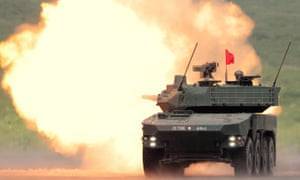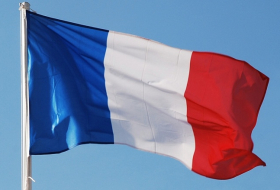Japan’s defence ministry has requested a record budget as it seeks to counter North Korea’s nuclear and missile threats and respond to growing Chinese air and naval activity in the region.
If approved by the cabinet and parliament later this year, the 5.3tn yen (£37bn) budget would be a 2.1% increase on last year and the seventh consecutive rise under Japan’s conservative prime minister, Shinzo Abe.
The budget request, released by the ministry on Friday, includes 424bn yen for missile defence – a steep rise from the 180bn yen spent last year. A significant portion of that – 234.3bn yen – would go on two US-made Aegis Ashore missile defence systems that would be deployed on land specifically to track and intercept missiles from North Korea.
Japan’s military also wants funds for a ship-to-air SM-3 Block IIA interceptor with expanded range and accuracy, developed jointly by the US and Japan, as well as upgrades to fighter jets and destroyers to make them compatible with advanced interceptors.
This week, defence officials said Japan must retain its hardline stance against the regime in Pyongyang, despite a slight easing in tensions following the summit in June between Donald Trump and Kim Jong-un.
In its annual defence review, Japan said North Korea continued to pose a “serious and imminent threat”, having conducted three nuclear tests and launched 40 ballistic missiles since the start of 2016.
North Korea fired two ballistic missiles over northern Japan last year, triggering warnings for residents to seek shelter.
Trump, meanwhile, has used North Korean nuclear and missile tests to encourage Japan and South Korea – home to tens of thousands of American troops – to buy “highly sophisticated military equipment” from the US.
Abe has cited Pyongyang’s race to develop nuclear weapons and ballistic missiles as proof that Japan must bolster its defence capabilities and loosen some of the constitutional shackles imposed after the second world war on its self-defence forces.
Japan’s constitution – drafted by the US during its occupation after 1945 – forbids the use of force to settle international disputes and confines the military to a strictly defensive role. While he has so far steered clear of altering the constitution, Abe pushed through a law in 2015 allowing Japan to exercise collective self-defence – coming to the aid of an ally – which would theoretically enable its forces to fight overseas for the first time since the second world war.
Abe, who has built a political career around opposition to the restrictions imposed by the constitution, is expected to start work on clarifying the military’s legal status if he is victorious, as is anticipated, in the election for president of the governing Liberal Democratic party next month.
This week, he said the security environment surrounding Japan had become “more severe and uncertain” in recent years.
The defence review noted the significance of Trump’s meeting with Kim in Singapore, but officials in Tokyo said they had yet to see progress on the North Korean leader’s vague pledge to denuclearise.
Japan remains wary of China’s rising defence spending, its construction of military facilities in the South China Sea and naval and maritime activity near the disputed Senkaku islands in the East China Sea.
To counter the rising capability of China’s air force, the defence ministry requested 54bn yen to upgrade F-15 fighters and 92bn yen for six F-35 stealth fighters.
In March, Beijing announced an 8.1% increase in its defence budget to 1.11tn yuan (£125bn), as part of efforts to modernise the Chinese military.
More about:
















































